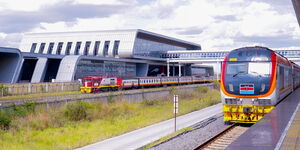Living and working in Nairobi often means waking up very early to beat traffic or adding an average of an hour to what would be a 20 or 30-minute drive.
In fact, various studies and traffic indexes indicate that the average commuter in Nairobi spends between 50 and 60 minutes in traffic per day. According to Numbeo's mid-2024 Traffic Index, the average commute time in Nairobi was 52.7 minutes. This placed Nairobi second among African cities with the worst traffic.
But this headache could soon be a thing of the past. This is thanks to at least five major infrastructure projects being done by the government.
These are the Ngong Road – Naivasha Road Flyover, Kenyatta Avenue Viaducts, Green Park Pedestrian Underpass, Nairobi Northern Bypass Expansion and the proposed Rironi-Mau Summit Road upgrade.
Each of these roads is being done with the goal of providing alternatives for motorists and ending traffic choke points around the capital. Collectively, these mega infrastructure projects will cost the government nearly Ksh200 billion, marking a significant investment around the capital.
Kenyatta Avenue Viaducts
Simply put, this is a kind of expressway that wants to reduce congestion at the Kenyatta Avenue and Haileselassie roundabouts. The road is similar to the construction done at the T-Mall roundabout along Lang’ata Road.
Contractors will build an overpass connecting Valley Road to the Kenyatta Avenue/Ngong Road/Nyerere Road Interchange. The same project will see a similar construction to connect Upper Hill and Haile Selassie to make sure the traffic does not meet, as is the case with the roundabouts.
The dual carriageway, approximately 1 kilometre long, includes dedicated cycle lanes and pedestrian walkways to promote road safety and cater to cyclists and pedestrians.
This is one of the projects revived by President William Ruto’s government after stalling due to non-payment. It was launched in September 2020, but only began construction in July this year.
It is expected to be completed by December 17, 2026. Once complete, motorists travelling from the Community area to Westlands are projected to save between 20 and 30 minutes during rush hour.
Green Park Pedestrian Underpass
Perhaps one of the most exciting pieces of infrastructure in Nairobi, that is, if you close your eyes to the eye-catching Talanta Stadium, the Green Park Pedestrian Underpass is nearly complete.
The Ksh2 billion project is a series of underground tunnels that will remove all human traffic from the junction of Haile Selassie Avenue, Ngong Road and Uhuru Highway.
The 500-metre is fully fitted with lifts, escalators, CCTV surveillance, commercial stalls, public washrooms and water tanks for hygiene and emergency use to make a 24-hour transit hub.
Borrowing from other modern cities like Beijing, the government expects this project to offer safe passage for pedestrians and a marketplace for traders who often have to lay their products on the walkways.
By removing the human traffic from the road, KeNHA expects to reduce the congestion around this crucial roundabout. And once the viaducts are complete, there will be little to no congestion along this corridor.
Its construction started in March 2024, and as of September 2025, the project is nearly 90 per cent complete.
Ngong Road – Naivasha Road Flyover
The Ngong–Naivasha Road Flyover is a Ksh3.58 billion project designed to untangle the traffic choke points near Junction Mall.
Construction began in early 2024 under the funding from the Spanish concessional loan. The project features a four-lane elevated bridge stretching roughly 800 metres above the busy Ngong Road–Naivasha Road intersection.
The flyover will allow vehicles travelling between Dagoretti, Karen and Kawangware to bypass the slow ground-level cross traffic.
Its design also includes redesigned sidewalks and protected walkways under the structure for pedestrian crossing. KURA expects the road to be complete by July 2027.
Once operational, the flyover is expected to cut up to 30 minutes from peak-hour journeys between Karen and the CBD.
Nairobi Northern Bypass Expansion
This Ksh29.3 billion project, approved by the Cabinet in June, will transform the single-carriageway stretch of the Nairobi Northern Bypass between Ruaka and Ruiru into a modern dual carriageway.
The upgrade includes new service lanes, improved drainage and multiple grade-separated interchanges to eliminate dangerous right turns and U-turns.
Once construction contracts are awarded, works are expected to run for about two to three years, with a likely completion window of 2028.
The dual carriageway will give motorists a faster link between Kiambu, Thika Road and the Jomo Kenyatta International Airport corridors, providing an alternative to the heavily congested Thika Superhighway and Outer Ring Road.
Traffic models show that the expanded bypass will reduce heavy-truck travel times by up to 40 per cent.
Rironi–Mau Summit Road Upgrade
The Rironi–Mau Summit highway upgrade is the largest of the five projects, carrying a staggering price tag of about Ksh160 billion.
Groundwork began with preparatory and financing agreements in 2024, following earlier PPP negotiations, and full-scale construction is slated to unfold in stages through 2029.
The project will dual and rehabilitate approximately 175 kilometres of the A8 corridor from Rironi in Kiambu County through Naivasha and Nakuru to Mau Summit.
The design calls for a modern four-lane dual carriageway with controlled access, new service roads, pedestrian overpasses, and high-capacity interchanges.
Tolling plazas are planned under the public–private partnership model to finance maintenance and operations over a multi-decade concession period.
When complete, the upgraded corridor will slash travel times between Nairobi and western Kenya by over an hour during peak periods like Easter and Christmas holidays.
These roads are all part of the government's efforts to increase ease of movement, which is aimed at unlocking more economic activity and lowering business costs while creating employment for more Kenyans.












